Get your little ones moving with these kids’ exercise tips from the experts.
According to a research by Public Health England half of the children are overweight in parts of Britain. Many children who aren’t overweight still don’t get enough exercise, which can have serious negative effects on their health, cognitive development and school attendance. But by making sure they eat well and get plenty of physical activity, you can help your children stay healthy and fit.
Here’s what you need to know about kids’ exercise:
How Much Exercise Should Kids Get?
The Centers for Disease Control and Prevention (CDC) recommends that children and adolescents get at least 60 minutes of moderate to vigorous physical activity each day. This may sound like a lot, but the full hour doesn’t have to occur all at once. “The effects of exercise are cumulative,” says Dr. Rani Whitfield, a physician in family practice and sports medicine and an American Heart Association spokesperson. “Exercise can be spread out over the day.”
It doesn’t even have to be traditional exercise. It simply has to be any activity that gets kids moving, like playing catch or chasing the dog around the backyard. “We want this to be fun for kids, and we want them to have a lot of variety,” says Lisa Perry, a national adviser on physical activity and physical education for Alliance for a Healthier Generation. You’ll know your kids’ exercise is intense enough if they’re breathing hard and sweating lightly.
What Kinds of Activities Should Kids Be Doing?
Physical activity is divided into three types, each of which kids should do at least three times a week. The first is aerobic activity, which includes riding bikes, walking briskly, playing tag, swimming and playing sports such as basketball and soccer. The second is muscle-strengthening activities, which includes weight-bearing activities such as climbing trees, playing on a jungle gym and doing pushups. The third type is bone-strengthening activities such as skipping, hopping and running.
Keep in mind that many activities fit into more than one category. Gymnastics, for instance, is both muscle-strengthening and bone-strengthening. Jumping rope is both aerobic and bone-strengthening.
What Are the Benefits of Exercise for Kids?
Regular exercise gives kids stronger muscles and bones, makes their hearts healthier, improves their immune function and decreases their obesity and diabetes risk. But the benefits aren’t just physical.
“Studies show that kids perform better in school when they have a chance to take a break and burn off energy,” says Dr. Blaise Nemeth, an American Academy of Pediatrics spokesperson and a paediatric orthopaedist. “Physical activity also helps the brain work better. Kids can focus better.”
Physical activity can also reduce anxiety and depression, says Perry. “It helps promote overall positive mental health.”
How Do You Get Kids to Want to Exercise?
Sometimes all it takes to get the kids off the couch is a bit of creativity. Here are a few ideas:
- Set up an Obstacle Course
This can be in your backyard, garage or basement. “Use things like hula hoops and buckets as obstacles,” suggests Dr. Nemeth.
- Do a Scavenger Hunt
“Make a list of items in your neighbourhood, then go out and look for them,” says Perry.
- Make a Family Exercise Video
“Break out the camera and some cool gear and let the production begin,” says Dr. Whitfield. “The fun you’ll have making the video and exercising to it will last forever.”
- Have a Dance Party
Turn on some music and dance with your kids. “It’s not only fun, it burns calories,” says Dr. Whitfield.
- Brave the Elements
If it’s snowing, head outside with your kids and build a snowman or go sledding. If it’s raining, dress them in old clothes and let them splash in the puddles. “Kids love to get dirty,” says Dr. Nemeth.
Of course, the best way to encourage your kids to be more active is to be active yourself. “Parents need to lead by example,” says Dr. Whitfield. So put down the remote control and go for a walk. Play hide-and-seek. Set up a game of hopscotch in the driveway.
“Moving daily is essential for a child’s growth and development,” Dr. Whitfield says. “If you make the time to exercise as a family, children will realize that it is important and fun, and it will become routine.”
Text source: Jennifer Marino Walters is a Washington, D.C.-based writer specializing in children’s and parenting topics. She enjoys being active with her husband, preschool-age twin boys and baby girl.






